

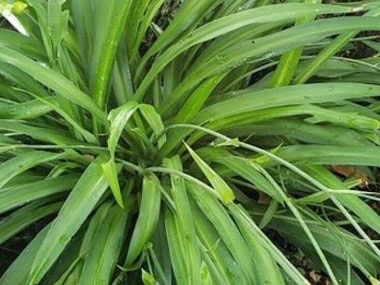
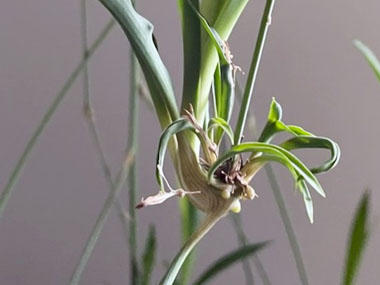
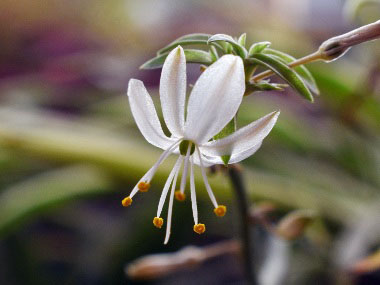
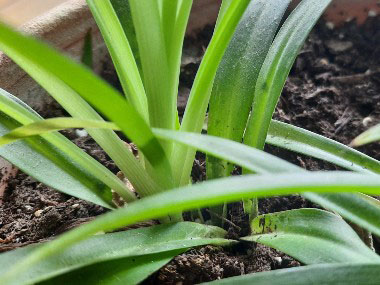
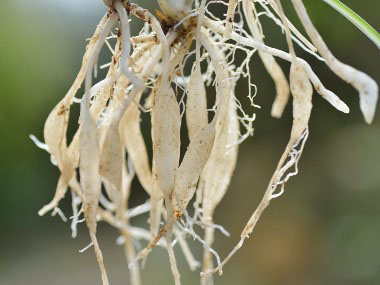
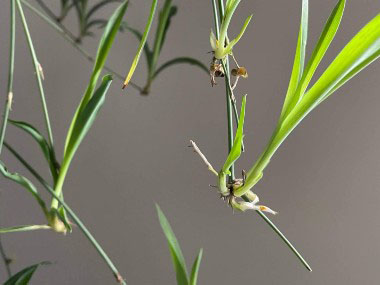

To support our efforts please browse our store (books with health benefits, etc.).
Chlorophytum comosum is a perennial evergreen herb that is known as the spider plant. This plant is commonly recognized as a houseplant in several countries throughout the world. These grow wild in many regions of Africa, the Middle East and India and are consumed as a leafy green vegetable. They are in the Asparagaceae family. Other common names include airplane plant, ribbon plant, hen-and-chickens, hen-en-kuikens and iphamba. Spider plants are very popular in cultivation due to their drought-tolerance and their relatively disease and pest-free nature. It grows prolifically and the rhizomes can reach up to 15cm long. It is reported to help keep the liver healthy liver, cures cough and cold, is anti-cancerous and is a potential prebiotic. It is also supposedly beneficial in bone healing and with burns.
Distinguishing Features
The species Chlorophytum comosum has long, thin, medium to dark-green satiny leaves. However, the Chlorophytum comosum Vittatum is the most commonly grown spider plant and has long recurved medium green leaves with a broad central white stripe.
Flowers
The individual flowers are white, star-shaped, and up to 2cm in diametre with 6 stamens. The tepals are oblong, up to 1cm long. The style is smooth and small with a minute point (stigma). The flowers grow in axillary fascicles. In the wild, the flowering period is throughout the summer months. The flowers are often replaced by vegetative leafy buds, which root for reproduction.
 Fields
of Nutrition has medicinal benefits and vitamin/mineral content of Spider Plant.
Fields
of Nutrition has medicinal benefits and vitamin/mineral content of Spider Plant.
Leaves
The linear leaves grow in a dense basal rosette, are bright light to dark green, smooth with a prominent mid-vein and channelled. The leaves measure about 30cm long and 2cm wide, end in a soft point and they have smooth margins.
Height
This plant can grown up to 1m (3') tall and 1m in diametre.
Habitat
Spider plants often grow in dominant stands in forested moist river valleys. The succulent roots enable the plant to cope during dry winter conditions. It thrives in a variety of soils (volcanic or sedimentary) derived from sandstone, shale, dolorite or granite. The soils are usually slightly acidic. They tend to grow in part to full shade areas.
Edible Parts
Leaves are known to be edible in small quantities. In some parts of Africa this is known as a potherb. According to the University of Florida, Chlorophytum comosum (Vittatum) contains phosporus, potassium, calcium and magnesium. Micronutrients include copper, iron, manganese and zinc. Chlorophytum comosum root tubers are a good source of sodium and potassium. They also contain fat and protein.
Similar Plants
Chlorophytum comosum Vittatum.
Winter Survival Food Handbook

PDF Plant Magazines
Types of Wild Food
Geographic Zones Seasons
Disclaimer
EdibleWildFood.com is informational in nature. While we strive to be 100% accurate, it is solely up to the reader to ensure proper plant identification. Some wild plants are poisonous or can have serious adverse health effects.
We are not health professionals, medical doctors, nor are we nutritionists. It is up to the reader to verify nutritional information and health benefits with qualified professionals for all edible plants listed in this web site. Please click here for more information.
Why Edible Wild Food?
- Food costs are rising
- Free, wild food is readily abundant
- Wild food adds nutrition to your diet
- Wild food can help treat various medical conditions





